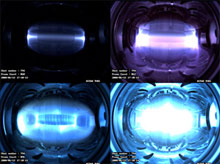Scientists operating Korea's next-generation nuclear fusion reactor have reported their first generation of plasma, saying it marked progress in futuristic experiments to create limitless energy for human use.
The device, called KSTAR, an abbreviation for Korea Superconducting Tokamak Advanced Reactor, generated plasma inside its inner chamber for the first time.
The reactor is the second of its kind in the world to generate plasma using superconducting material. China was the first with its EAST reactor in 2006, according to Kwon Myeon, a director at the National Fusion Research Institute.
In the experiments the plasma lasted for 249 milliseconds at above 100 kilo-amperes (KA) current with the maximum current reaching 133 KA, according to officials from the state-run National Fusion Research Institute.
Originally, the goal for the KSTAR scientists was to maintain plasma for 100 milliseconds, or 0.1 seconds, above 100 KA.
``The generation of plasma proves that KSTAR is ready to operate and contribute significantly to the research for nuclear fusion," said Ryu Koo-hee, an official from the nuclear fusion research division at the Ministry of Education, Science and Technology.
``KSTAR is also one of the world's few fusion reactors that use Nb3Sn as superconducting material, identical to the design of the ITER reactor, which strengthens Korea's potential contribution to the international ITER effort."
Plasma, generated from the ionizing of hydrogen gas, is a state in which the electrons and the nuclei are separated, considered a crucial step before nuclei can collide and fuse.
Fusion reactors generate power by the heating of hydrogen plasma, which causes hydrogen isotopes to fuse and release energy. The duration of the plasma is critical for this process and the reactors are designed with powerful magnetic chambers using superconducting magnets to contain the plasma.
Nuclear fusion is regarded as one of future energy solutions that are limitless in sourcing, a key alternative to the limited and depleted sources of fossil fuels. The viability of the technology is still debated.
To put it simply, nuclear fusion is the process that makes the sun shine, with the nuclei of small atoms, such as hydrogen, squeezed together and heated to an extreme degree such that they fuse to form larger nuclei and release a burst of energy.
Scientists have long been researching ways to create and control the nuclear fusion process for constructive use.
Conventional nuclear power plants depend on materials such as uranium or plutonium to create the fission to generate energy, but the radioactivity of the resulting fragments are considered a crucial drawback. In a nuclear fusion reaction, however, problems about waste disposal are greatly minimized.

